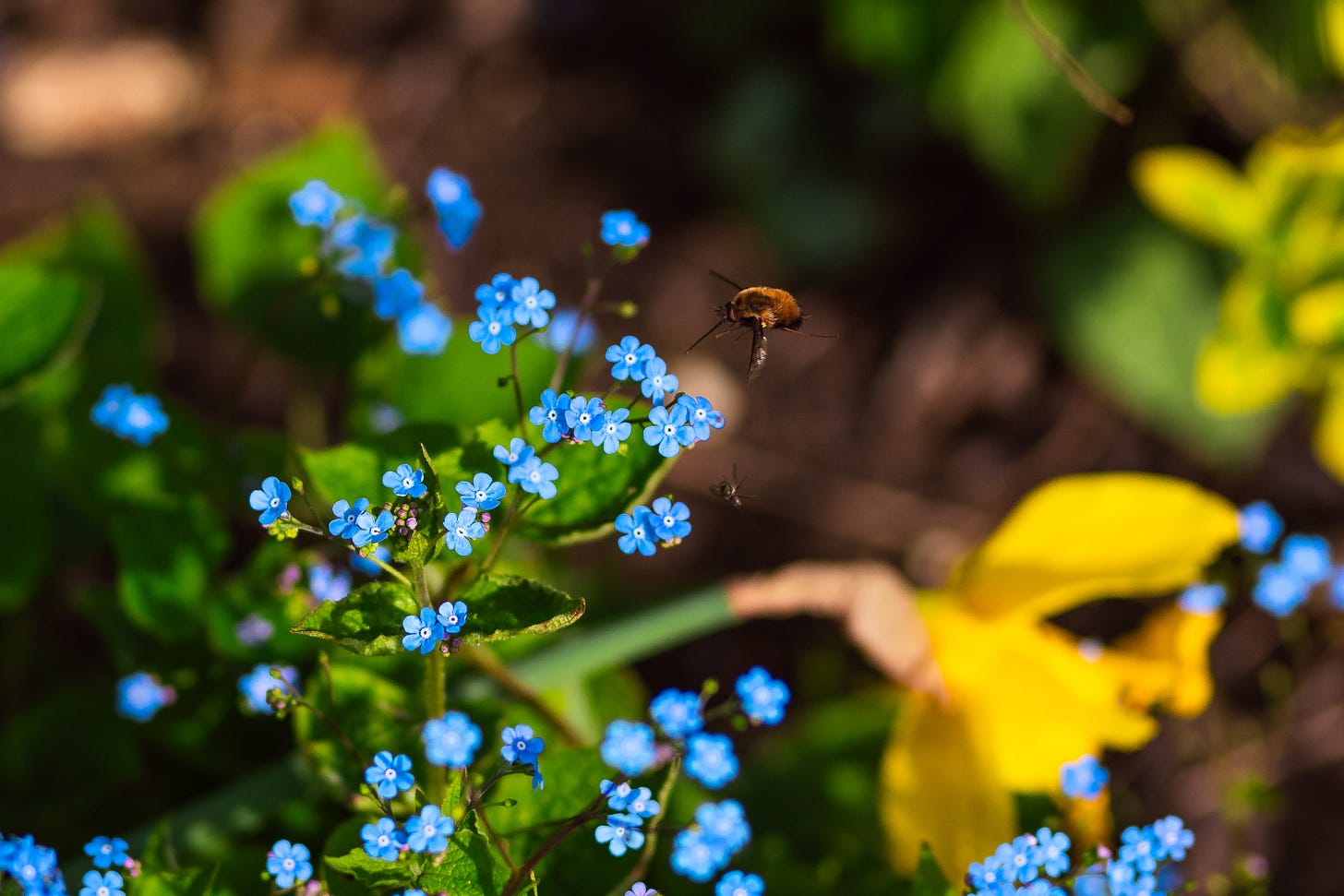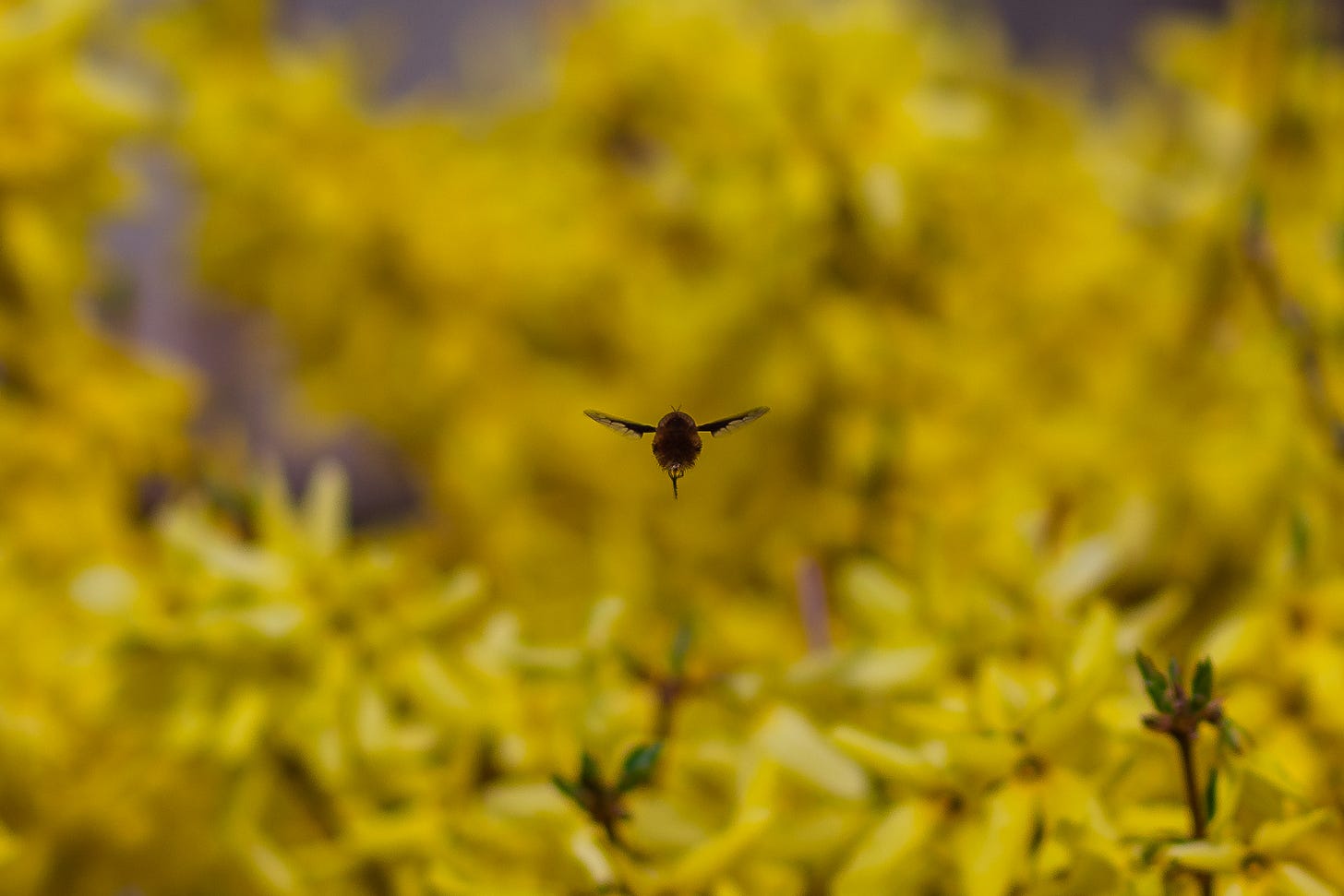
Spring has officially sprung and it’s brought bee-flies with it! They’re cute and they’re fluffy and they’re a joy to watch. They hover like hummingbirds over flowers and use their long tongues (proboscis) to feed on common plants. They look like fuzzy bees but they’re actually flies. Oh, and they’re also parasites whose larvae suck the life out of actual bee grubs.

It’s the dark-edged bee-fly (Bombylius major) I’m most familiar with. This week, after days of admiring these sweet little bundles of fluff, I looked them up only to discover that their larvae are parasitoids: parasites that will eventually kill their hosts. Here’s how they do it:
A female will scoop up sand and gravel using what Dr Erica McAlister, Senior Curator of Diptera at the Natural History Museum (NHM), calls “a twerking motion”. This helps her camouflage her eggs, as well as protect them and give them some extra weight. Her ovipositor (egg-laying tube) has a spine that then allows her to flick the eggs into a solitary bee’s nest. “She is essentially carpet-bombing her eggs” says Erica.
Bee-flies must lay their eggs quickly, as not only do they need to do it while the adult bees are away from their nest, but they’re competing with other flies and wasps who are trying to parasite the solitary bees too.
Don’t feel too bad for the bees though - according to scientists, at least 40% of all described insect species are parasites and around a quarter of British solitary bees themselves are brood parasites or ‘cuckoo bees,’ which search out the nests of their hosts, where they will lay their eggs. As Erica says: “It's carnage and mayhem in your garden”.
When the bee-fly eggs hatch, their larvae get to work, using ‘false legs’ to enter the burrow of the bees and feeding on any pollen intended for the bee babies. The bee-flies then go through something called hyper-metamorphosis, which Erica says is “like going from an active toddler to an enormous, sedentary teenage larva that eats the bee grubs”. A gruesome but nevertheless “healthy part of the ecosystem”, according to NHM.
I’ll never look at these cuties in the same way again!
The dark-edged bee fly is a contender for 2025’s Invertebrate of the Year - cast your vote now!

How to spot and identify a bee-fly
The dark-edged bee-fly (Bombylius major) is one of the earliest bee-flies to emerge in spring and you can often find them sunbathing on warmer days (typically 17ºC or higher) from around March in the UK. They like to feed from flowers that are purple, violet, blue or white and aren't attracted to bright yellow or pink flowers quite as much. Try hanging around a patch of violets, ground ivy, green alkanet or primroses long enough and you might just see one!
Dark-edged bee-flies look like fluffy golden bees with huge black fly eyes. Unlike bees though, they have only one set of wings, which have a dark band along their front. Their straw-like proboscis gives them the nickname ‘flying narwhal’.
In some places in the UK, you may also find the dotted bee-fly (Bombylius discolor) which looks very similar, but has dotted wings. Females also have a line of white dots on their rear end.
Rarer species, which can be found in certain locations at specific times of year include the western bee-fly (Bombylius canescens), the heath bee-fly (Bombylius minor), the villa bee-fly (Villa cingulata, V. modesta and V. venusta), the mottled bee-fly (Thyridanthrax fenestratus), the flea bee-fly (Phthiria pulicaria), and the black-winged bee-fly (Anthrax anthrax). Find out more here.
Sources and Further Reading
NHM: Meet the bee-fly: the cute bee mimic with a dark side
Worcestershire Wildlife Trust: Taking a bee-fly for a walk
The Wildlife trusts: Dark-edged bee-fly profile
Ed Phillips: Solitary Bees and Parasitic Flies
The Guardian: Meet the twerking pollinator with a bum-bag: the dark-edged bee-fly
Earlier this week I hosted a nature journaling workshop as part of Happier Outdoors Festival, where I was overjoyed to find someone made a whole zine all about bee-flies!
Find out more about the free nature, health and happiness events happening in Greater London until 16th April at happieroutdoors.london






The very day I read this article (or rather because of it!) I noticed and recognised a bee fly for the first time in my life. A coincidence but also a lovely example of how an article can open your eyes. Your title and sub-title caught my attention and they capture the little beastie perfectly. Thank you!
I love bee flies. Find it crazy that a few years ago I didn’t know what they were and now I see dozens just in the garden (which I hope means a healthy population of solitary bees too). Nature is amazing. In my garden they seem to particularly like forget me nots and primroses & we have plenty of both.